Tehani Croft Wessely's Blog, page 15
August 4, 2014
Snapshot 2014: Michael Pryor
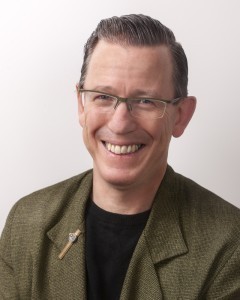 Michael Pryor writes fantasy and science fiction for teenagers. He has published over thirty novels and more than 50 short stories. He has been shortlisted for the Aurealis Award six times, and seven of his books have been CBCA Notable books. His latest book is Machine Wars for middle grades readers, and his website is www.michaelpryor.com.au.
Michael Pryor writes fantasy and science fiction for teenagers. He has published over thirty novels and more than 50 short stories. He has been shortlisted for the Aurealis Award six times, and seven of his books have been CBCA Notable books. His latest book is Machine Wars for middle grades readers, and his website is www.michaelpryor.com.au.
1. Your latest book is Machine Wars, a science fiction novel, but most of your books in recent years have been fantasy (particularly steampunk) – how do you have to adjust your headspace for these different types of storytelling?
The aspect I notice most of all, moving from Fantasy to SF, is the language I use. I’ve been using deliberately formal, slightly old-fashioned language in my Steampunk Fantasies to help scene setting, but ‘Machine Wars’ is a near future story so I had to re-set my language use for a more contemporary feel. It took a little while!
2. All of your work to date has been for young people (I think!), although I can attest to the appeal for adults as well. Do you have any inclination to write for an adult audience?
I have written short stories for adults, but not for some time, and I would like to take up writing for that audience again, and in a longer format. In fact, the Work in Progress is just that. To tell more would be premature, I’m afraid, since I’m at the very tentative first steps in my first draft. Stay tuned.
3. What can we look forward to from Michael Pryor in the near future?
As mentioned, I hope this adult novel will come to fruition, but I’m also working on a piece of madcap silliness for younger readers, plus a fantasy romance for older readers. This latter is something close to my heart, and it’s in a space where I feel not enough male writers are writing. We’ll see how this one goes.
4. What Australian works have you loved recently?
I’m really impressed by the quality of the stories that are coming through Aurealis this year. For a hit pick, keep an eye on a story from a new writer, Steven Ma: ‘Ballard and Ballard: A Biopunk Detective Tale of 2080 AD’. Its setting is urban Australia and it’s gritty, wry and stylish.
5. Have recent changes in the publishing industry influenced the way you work? What do you think you will be publishing in five years from now?
The changes in the publishing industry keep coming, and they’re hard to ignore. I like to think that I’m still writing in the same way, doing my best to tell engaging stories with characters to care about, but the takeovers, mergers and re-alignments in the industry can be nervous-making – and I probably write best when I’m confident and assured that the business side of writing is stable. Five years from now? That’s a long time in publishing! I’d like to think that I’ll still be writing a couple of books a year, maybe one for adults and one for teen/YA readers. I wouldn’t like that to be written in stone, though. One of the delightful things about my life at the moment is the flexibility. I’m able to take up challenges and opportunities that present themselves unbidden, and that’s invigorating.
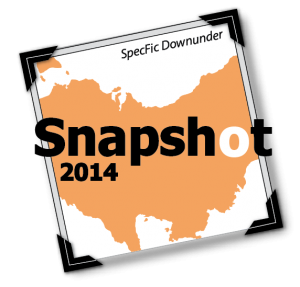 This interview was conducted as part of the 2014 Snapshot of Australian Speculative Fiction. We’ll be blogging interviews from 28
July to 10
August and archiving them at SF Signal.
You can read interviews at:
This interview was conducted as part of the 2014 Snapshot of Australian Speculative Fiction. We’ll be blogging interviews from 28
July to 10
August and archiving them at SF Signal.
You can read interviews at:
http://bookonaut.blogspot.com.au/search/label/2014snapshot
http://www.davidmcdonaldspage.com/tag/2014snapshot/
http://fablecroft.com.au/tag/2014snapshot
http://helenstubbs.wordpress.com/tag/2014snapshot/
http://jasonnahrung.com/tag/2014snapshot/
http://kathrynlinge.livejournal.com/tag/2014snapshot
http://mayakitten.livejournal.com/tag/2014snapshot
http://www.merwood.com.au/worldsend/tag/2014snapshot
http://crankynick.livejournal.com/tag/2014snapshot
http://randomalex.net/tag/2014snapshot/
http://stephaniegunn.com/tag/2014snapshot/
http://tansyrr.com/tansywp/tag/2014snapshot/
http://tsanasreads.blogspot.com/search/label/2014snapshot
http://ventureadlaxre.wordpress.com/tag/2014snapshot/
August 3, 2014
Snapshot 2014: Stephen Ormsby (Satalyte Publishing)
Stephen C. Ormsby was a novelist with 2 books published by small press in America, before moving into publishing with his wife, Marieke.
Find Satalyte online at http://Satalyte.com.au, on Twitter at @SatalytePublish and on Facebook at https://www.facebook.com/SatalytePublishing
1. Satalyte Publishing is a fairly new operation, but you’ve hit the ground running – what made you decide to start your own publishing house?
I had a couple of novels published in America through small press, but had terrible trouble getting them to Australia. As I say, I threw a tantrum in the corner, stomped my feet and told my wife, Marieke, that I’m going to start a publishing house. Her reaction was ‘umm, okay, you do know that we are pregnant.’ I replied that can’t be that hard. We still laugh about that one. Well, at least one of us does!
2. In less than 12 months you’ve released nearly 20 books – that’s an astonishing achievement! How have you selected the projects and found the time to produce them all?
Finding time, now that a fun question. We are actually doing this full time at the moment, and hope to continue doing so. When we opened submissions, we found that there was so much interesting stuff out there. It was so hard to knock them back, and that leads to our unfathomable workload.
3. What’s coming up next for Satalyte?
We hope to continue at the frenetic work rate, and if all goes to plan, we should release some 30 novels in the next year. We will still be on the convention trail, and look like hitting Conflux, Supanovas as well as a number of book launches. Lots of kilometres to travel.
4. What Australian works have you loved recently?
To tell you the truth, I do not get that much time to read anymore. I am mostly editing, and am finding hard to read works without looking through an editor’s eye. There are so many that I would like to read, but they are just stacking up on my TBR list.
5. Have recent changes in the publishing industry influenced the way you work? What do you think you will be publishing in five years from now?
Another honesty – I do not have any real knowledge of the publishing industry five years ago. I was only a reader, and a part time writer. I had never considered that I would be doing this even that time ago.
I believe we will see that print will come back, with ebook plateauing. I see that Australian authors and their respective works will find more relevance in the market, through the hard work of a new wave of presses and the stalwarts.
In five years time, I hope to have Satalyte Publishing in a position that we will be able to publish the best Australian writing to the world.
 This interview was conducted as part of the 2014 Snapshot of Australian Speculative Fiction. We’ll be blogging interviews from 28 July to 10 August and archiving them at SF Signal. You can read interviews at:
This interview was conducted as part of the 2014 Snapshot of Australian Speculative Fiction. We’ll be blogging interviews from 28 July to 10 August and archiving them at SF Signal. You can read interviews at:
http://bookonaut.blogspot.com.au/search/label/2014snapshot
http://www.davidmcdonaldspage.com/tag/2014snapshot/
http://fablecroft.com.au/tag/2014snapshot
http://helenstubbs.wordpress.com/tag/2014snapshot/
http://jasonnahrung.com/tag/2014snapshot/
http://kathrynlinge.livejournal.com/tag/2014snapshot
http://mayakitten.livejournal.com/tag/2014snapshot
http://www.merwood.com.au/worldsend/tag/2014snapshot
http://crankynick.livejournal.com/tag/2014snapshot
http://randomalex.net/tag/2014snapshot/
http://stephaniegunn.com/tag/2014snapshot/
http://tansyrr.com/tansywp/tag/2014snapshot/
http://tsanasreads.blogspot.com/search/label/2014snapshot
http://ventureadlaxre.wordpress.com/tag/2014snapshot/
August 2, 2014
Snapshot 2014: Greg Mellor
Greg Mellor is a Canberra-based author with over 50 published short stories.
His debut SF collection Wild Chrome was published in 2012, and he has several SF novellas coming out, starting with Steel Angels in 2014 and Weapons of Choice in 2015. He is a regular contributor to Clarkesworld Magazine and Cosmos Magazine, plus his work has appeared in Aurealis and AntipodeanSF and a range of Australian and US anthologies. He reached the finals of the Aurealis Awards a few times and is a member of the SFWA.
Visit www.gregmellor.com to see his latest publications.
He likes cats, cars and consciousness theories.
1. You have a new novella coming out this year – who is publishing it, and can you tell us a bit about it?
 Steel Angels is set in a post-apocalyptic future where the Earth has dried out and the fragmented societies left behind are dominated by cartels that control the limited resources and supply chains. A community of people – the angels – have chosen a different path and salvaged some of the old defence and space technology. They now live in helium eyries in the stratosphere. Their bodies are part genetic art, part technological augmentation and they are seeking transcendence of a kind and a way off the planet.
Steel Angels is set in a post-apocalyptic future where the Earth has dried out and the fragmented societies left behind are dominated by cartels that control the limited resources and supply chains. A community of people – the angels – have chosen a different path and salvaged some of the old defence and space technology. They now live in helium eyries in the stratosphere. Their bodies are part genetic art, part technological augmentation and they are seeking transcendence of a kind and a way off the planet.
The story follows Micah, the reluctant protagonist sent by one of the cartels to capture an angel and bring back the technology and the secret to immortality. Micah gets more than she bargained for and ends up confronting the beautiful, powerful angel called Gale. What follows is a cat and mouse game of lust and betrayal as Micah discovers how far the cartel is willing to go to unlock the angels’ minds. And as she gets closer to Gale she uncovers the brutal truth behind the angels’ experiment to evolve human consciousness.
The story is definitely hard SF, but laced with some philosophy about the evolution of consciousness and a few shocking moments and a fast pace that is characteristic of my short stories. I was deeply moved by Nicholas Humphrey’s book Soul Dust, which outlines a theory of how human consciousness is possible. I’ve read a lot on the subject and found his book very inspiring. So much so that I contacted Nick and he kindly gave me permission to quote some of his stuff in Steel Angels.
Initially it was tricky to break out of the short story mode, but I’ve been really pleased with the progress. I‘m still in negotiations with the US publisher and the book is due out at Christmas. The cover art is sorted now. I wanted to keep the imagery consistent with my brand, so I went back to Jamie and Leanne Tufrey. The sneak peak I’ve attached here has just been released on my website and Facebook page. I’m stoked with the final result as it’s a full panoramic that wraps round to the back cover.
2. In 2012 your collection Wild Chrome came out from Ticonderoga, and two stories from the book were shortlisted for the Aurealis Awards (not your first appearance on those lists, either) – you’ve also had stories published in several professional markets. However, I’m interested in the time between 1994 (your first story sale to Aurealis magazine) and the late 2000s, when you came back to publishing your work – can you tell us about that long break between published works?
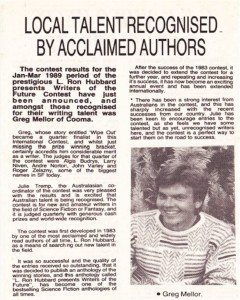 Good question! I suppose it goes back a little further than 1994. Writing became a hobby after I left university. I used to write articles on astrophysics for local newspapers and began experimenting with short stories across SF, fantasy and horror genres. I reached the quarter finals of the Writers of the Future contest in 1989, which was really the first time I realised I had some potential in SF. It was a big deal back then and I had a lot of newspaper and radio interviews as the contest had only been running for a few years and provided a starting point for authors like Robert Reed and others.
Good question! I suppose it goes back a little further than 1994. Writing became a hobby after I left university. I used to write articles on astrophysics for local newspapers and began experimenting with short stories across SF, fantasy and horror genres. I reached the quarter finals of the Writers of the Future contest in 1989, which was really the first time I realised I had some potential in SF. It was a big deal back then and I had a lot of newspaper and radio interviews as the contest had only been running for a few years and provided a starting point for authors like Robert Reed and others.
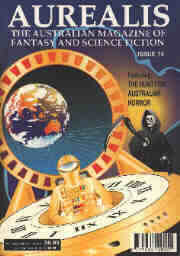 The publishing of “Rogue” in Issue #13 of Aurealis in 1994 was also very cool and was another sign that my writing had promise. However I was also at that stage in my life where I needed to find a job that actually paid, and writing wasn’t it. I ended up studying for an MBA and started a career in business consulting and that consumed me for a long time. Plus I did the “get married, take out a mortgage and have a child” routine, not necessarily in that order. I now have a beautiful, sometimes patience-testing, soccer-mad teenage boy.
The publishing of “Rogue” in Issue #13 of Aurealis in 1994 was also very cool and was another sign that my writing had promise. However I was also at that stage in my life where I needed to find a job that actually paid, and writing wasn’t it. I ended up studying for an MBA and started a career in business consulting and that consumed me for a long time. Plus I did the “get married, take out a mortgage and have a child” routine, not necessarily in that order. I now have a beautiful, sometimes patience-testing, soccer-mad teenage boy.
Even though I stepped away from fiction (a decision that used to nag at my subconscious an awful lot) I found that being a consultant did provide some creative outlet as I was writing reports on a whole range of topics such as business strategy, process reengineering, activity based costing, organisational change and online services. Business writing can be very dry, but I find the subject matter is interesting, plus your writing has to be compelling to the audience otherwise your clients don’t pay their bills!
But that kind of writing was never ever going to be enough – who was I kidding? I started experimenting again with SF in 2004/05 and produced a bunch of disjointed stuff that got some more quarter final places and left me feeling cynical and hollow. However what I did gain was the realisation that I had a whole lot of ideas that just needed a better narrative structure.
After a few more years of child raising and working stupid hours and mortgage repayments I said to myself “stuff this, I can and I will write at a professional level”. One of the triggers for this thought process occurred one day in 2008 when I was reading the submission guidelines to Cosmos magazine.
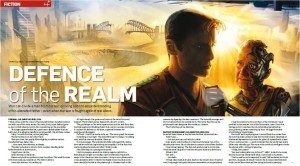 “Our standards are high, so we’re only interested in seeing the best. Unless you’re convinced your work is top-shelf, it’s probably best not to bother.”
“Our standards are high, so we’re only interested in seeing the best. Unless you’re convinced your work is top-shelf, it’s probably best not to bother.”
Well, that was like a red flag to a bull to me! It was as good as telling me “you can’t do it”, and I don’t receive that kind of commentary very well at all. So it was with a good pool of ideas and, yes, a good dose of rage that I submitted “Defence of the Realm” to Damien Broderick, the editor at the time.
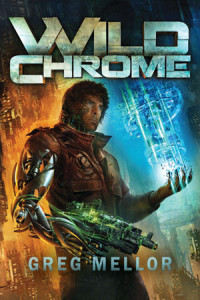 The story was published in 2009 and afterwards the floodgates well and truly opened up and I published a lot of stories in a very short timeframe. I don’t know that I’ll ever make up for all those years where I wasn’t writing fiction, but then again I think maybe it had to happen this way. I know now, after all the doubt and denial, that writing is an essential part of me.
The story was published in 2009 and afterwards the floodgates well and truly opened up and I published a lot of stories in a very short timeframe. I don’t know that I’ll ever make up for all those years where I wasn’t writing fiction, but then again I think maybe it had to happen this way. I know now, after all the doubt and denial, that writing is an essential part of me.
The support I received and the feedback from readers of Wild Chrome was astonishing. It was the most profound affirmation, I can’t even begin to describe how important it was and still is.
3. In the 2012 Snapshot, you told us that you felt very comfortable in the short story form and were starting to move into novellas – is there now a novel on the horizon?
I’ve got so much baseline material to work with that I need to give the novellas the space they deserve. Steel Angels this year will be followed by Weapons of Choice in 2015. This story appeared in a very condensed version in my collection, but there are ideas in there that just can’t be left in the shorter format. I have other stories from the collection that could also be expanded into a novella, such as Stranded Light, but I’m also very excited about some of the new stuff including Voodoo Protocol.
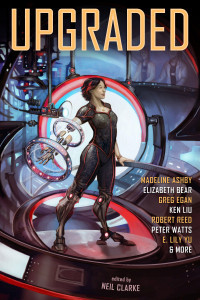 I’ll keep my hand in with short stories, so expect to see more through Clarkesworld Magazine. “Mar Pacifico” was published last year and “Fusion” is about to come out in Neil Clarke’s Upgraded anthology. Other stories in the pipeline include “Spring Solace”, “Falling from Distant Clouds” and “By Decree of a Forgetful God”.
I’ll keep my hand in with short stories, so expect to see more through Clarkesworld Magazine. “Mar Pacifico” was published last year and “Fusion” is about to come out in Neil Clarke’s Upgraded anthology. Other stories in the pipeline include “Spring Solace”, “Falling from Distant Clouds” and “By Decree of a Forgetful God”.
I am also expanding my product range to include some speculative fiction under a pseudonym. I’ve been working in collaboration with the fantasy and pinup artist Dave Nestler on an illustrated collection of short stories. I’m delighted with how the artwork has come together and I’m about two-thirds of the way through the story writing, so expect to see the book published later in 2015.
I just realised that I neatly dodged the question! The move to novel writing will happen, but it will need to coincide with a reduction in my work hours. Craig Cormick told me he writes a chapter every morning before going to work. I wish I could write that fast! I have a tendency to think a lot about the ideas and the storyline when I should just be pushing the words out on the screen. I guess that will come with time and I am finding that I’m comfortable now writing longer chapters and including more depth and detail in the novella format, so the novel is very definitely the next step.
4. What Australian works have you loved recently?
I’ve read three of Tim Winton’s books this year: Breath, Dirt Music and The Turning. I adore the power and simplicity of his style. And I’m just a little insanely jealous! I like the way he connects the characters with the land in Dirt Music – it’s one of the essential features of good fiction writing but Tim is a master at it. What I liked most about the book was the character arc and the extremes to which people will go to be found or be discovered as human beings who just want to be loved.
I also like the touching and brutal humanity of his characters in The Turning. I think everyone can relate to them in some way. I wasn’t a fan of the movie though. I think it’s really hard to portray the feelings in short stories onto the screen.
Cormac McCarthy also uses that powerful, uncluttered narrative in No Country for Old Men and The Border Trilogy. Not Australian, I know, but it’s that style that has captivated me this year.
5. Have recent changes in the publishing industry influenced the way you work? What do you think you will be publishing in five years from now?
Up until recently I would never have contemplated self-publishing. I’m generally my own worst critic, so I have always had the residual fear that if I self-publish stories that aren’t ready then it’s going to do more harm than good to my reputation. You don’t have to dig too deep into the internet to see some of the epic failures in self-publishing.
But you also don’t have to look too far to see some of the epic successes. I’m more comfortable with the idea of self-publishing now and I can use what I’ve learnt over the last few years to approach it with more confidence. I’m fortunate in that I sell every story I write, so the content must be okay. But I would never go into self-publishing with just content alone, I think you have to be willing to back your work with a good editor and a cover and interior design and some thought to marketing and advertising. That’s all doable in self-publishing I reckon if you’ve got the time.
In five years from now I’d like to be publishing (or self-publishing) a novel or two or three novellas a year. I think the only way for me to build my profile in the SF genre is to publish more in overseas markets. However I am expanding my horizons into other genres, so who knows what I might be writing in years to come.
 This interview was conducted as part of the 2014 Snapshot of Australian Speculative Fiction. We’ll be blogging interviews from 28
July to 10
August and archiving them at SF Signal.
You can read interviews at:
This interview was conducted as part of the 2014 Snapshot of Australian Speculative Fiction. We’ll be blogging interviews from 28
July to 10
August and archiving them at SF Signal.
You can read interviews at:
http://bookonaut.blogspot.com.au/search/label/2014snapshot
http://www.davidmcdonaldspage.com/tag/2014snapshot/
http://fablecroft.com.au/tag/2014snapshot
http://helenstubbs.wordpress.com/tag/2014snapshot/
http://jasonnahrung.com/tag/2014snapshot/
http://kathrynlinge.livejournal.com/tag/2014snapshot
http://mayakitten.livejournal.com/tag/2014snapshot
http://www.merwood.com.au/worldsend/tag/2014snapshot
http://crankynick.livejournal.com/tag/2014snapshot
http://randomalex.net/tag/2014snapshot/
http://stephaniegunn.com/tag/2014snapshot/
http://tansyrr.com/tansywp/tag/2014snapshot/
http://tsanasreads.blogspot.com/search/label/2014snapshot
http://ventureadlaxre.wordpress.com/tag/2014snapshot/
August 1, 2014
Snapshot 2014: Sue Wright (Tiny Owl Workshop)
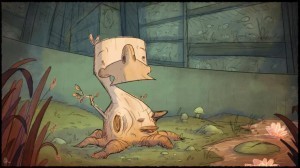
The Lane of Unusual Traders artwork by Simon Cottee
Tiny Owl Workshop is a very small publisher based in Brisbane. Sue Wright is the Tiny Owl go to person. She has too many teapots, too many books, and a mild obsession with pop surrealist art and doodling.
1. Tiny Owl Workshop is a fairly new operation. What made you decide to start your own publishing house?
I’d been thinking about it for a while. I’ve always loved stories, comics and books, they’ve been such a positive in my life, so when the circumstances were right I just plunged in. It’s been such a great creative release, bringing projects to life and curating collections of stories, and I hope to keep going.
2. The newest project for Tiny Owl is The Lane of Unusual Traders, an online shared world environment. Where did the idea for The Lane come from, and where do you hope to take it?
The idea for LoUTs was prompted a while back when Terry Pratchett invited his readers to name some of the places that might be found in The Shades, a particularly sinister part of Ankh-Morpork: the main city in his Discworld series. It was a short leap from there to the idea of a lane and a world slowly brought to life by many writers rather than one (though quite a fabulous one). We hope to take LoUTS as far as possible, but how far it goes really depends on the stories submitted, how well we can weave stories together and how writers, artists and readers engage with the idea and help it grow.
Publishing wise it means books (physical as well as digital), small comics (starting with one pagers), maybe inviting others to curate a small collection of stories related to a Story Lot or event, and games, toys and whatever else may emerge in time. Tiny Owl has also kept LoUTs Story Lot 1 to play with. We’ve made it an inn (recently named The Jolly Strangler by twitterer @Greybeard3). We’ll develop the story of The Jolly Strangler and hope to invite artists to hold exhibitions there, maybe have a writer in residence there. Recently, we’ve been chatting to Matt Hsu, from Brisbane band The Mouldy Lovers, to see if the Mouldies would be interested in being the first band to play at The Jolly Strangler. I don’t know how that will work yet, but it will. While the LoUTs prologue lends itself easily to fantasy-based stories we’re also hoping that a bunch of ‘real world’ stories emerge. It’d be interesting to see The Lane of Unusual Traders split into two parallel worlds that bump up against each other every now. The Lane has seen its first fan-fiction piece and the writer really gets how this could happen.
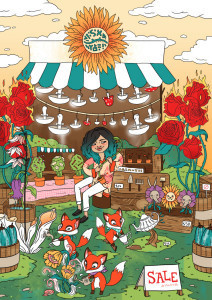
The Lane of Unusual Traders artwork by Lauren Carney
3. Could you tell us about some of the other projects you have coming up?
Krampus Crackers is the next project. It’s a flash fiction project being led by Kahli Scott, a young writer who we published as part of the Pillow Fight project in 2013. Kahli’s pretty great, she won the State Library of Queensland Young Writers Award in 2013 and was recently shortlisted for Hotkey Books Young Writers Prize AND is a submission reader for Aurealis Magazine, on top of working full time and living life. The project opens on 25 July and Kahli will be seeking 12 flash fiction stories inspired by Krampus—a fairly demonic character who was BFFLs with jolly St Nick once upon a time. There’ll be fabulous art too, from Simon Cottee, Seana Seeto, Terry Whidborne and more.
Noveltinis will be happening in 2015. Writer Patrick Ness was tweeting about nothing in particular one day—he sometimes just tweets about stuff he’s watching on TV—and he made up the word noveltini. I asked if Tiny Owl could use it, he said yes if we mentioned him, so Noveltini’s will be the name for the novellas we’re planning to publish next year. Artist and writer Kathleen Jennings is also working on a series of fairytale inspired illustrations for a small book that’ll come together in 2015—it may contain hounds. Of course LoUTs will still be happening and we’ll be launching the Unfettered collection and our children’s picture book ‘Will You Be My Sweetheart’ in November this year. We’re also still working with Terry Whidborne on a Fallen Art project and talking to local lovelies the Binky Collective about another found art project happening in 2015.
4. What Australian works have you loved recently?
I’m reading more ‘literary’ journals to check out emerging writers and immerse myself a little more in Australian writing. My older brother, Stephen, also writes for Overland Journal, so I always read Overland. Book-wise I’ve loved reading Robert Hoge’s Ugly, it’s such a warm, personal, real tale. Favel Parrett’s Past the Shallows is just beautifully written and I’m looking forward to picking up a copy of When the Night Comes which comes out in August. Shaun Tan’s Rules of Summer is stunning, visually beautiful and he uses words so sparingly. Tan is a favourite, and Eric is one of those books I carry around with me from time-to-time just for inspiration. Catherine Jinks’ City of Orphans books worked their way to the top of the ‘unread book tower’ recently, so I’ve also just finished reading the enjoyable boggart infested A Very Unusual Pursuit and A Very Peculiar Plague. Boggart catcher Alfred Bunce is a character Dickens would love.
5. Have recent changes in the publishing industry influenced the way you work? What do you think you will be publishing in five years from now?
Being so new, yes, definitely. Because we are so small (barely 1.5 people) and don’t quite have media- mogul-sized resources behind us, we have to work differently. It’s no bad thing though. The aim is to build community as we go, keep ourselves open to the opportunities technologies offer, keep connecting local writers and artists to global audiences, and make sure we bring writing, craft and art together to create unique work. What we’ll be publishing 5 years from now depends how the industry develops, what opportunities open up, and whether we’ve earned any money to plough back into other projects. I’ll shimmy out onto this here whippet thin limb and say that in five years the Amazon centralised model will be challenged by the massive growth of initiatives like maker centres and a rebirth of localised manufacturing helped along by changes in printing technology. 3D printing will help transform physical books into amazing tactile works that can be made to order locally and immersive technologies will bring books, games and movies even closer together. So I guess Tiny Owl will be producing amazing tactile books, and, in our magic-happy-dreamland, Weta Workshop will be building the film set for The Lane of Unusual Traders. 
This interview was conducted as part of the 2014 Snapshot of Australian Speculative Fiction. We’ll be blogging interviews from 28 July to 10 August and archiving them at SF Signal. You can read interviews at:
http://bookonaut.blogspot.com.au/search/label/2014snapshot
http://www.davidmcdonaldspage.com/tag/2014snapshot/
http://fablecroft.com.au/tag/2014snapshot
http://helenstubbs.wordpress.com/tag/2014snapshot/
http://jasonnahrung.com/tag/2014snapshot/
http://kathrynlinge.livejournal.com/tag/2014snapshot
http://mayakitten.livejournal.com/tag/2014snapshot
http://www.merwood.com.au/worldsend/tag/2014snapshot
http://crankynick.livejournal.com/tag/2014snapshot
http://randomalex.net/tag/2014snapshot/
http://stephaniegunn.com/tag/2014snapshot/
http://tansyrr.com/tansywp/tag/2014snapshot/
http://tsanasreads.blogspot.com/search/label/2014snapshot
http://ventureadlaxre.wordpress.com/tag/2014snapshot/
July 31, 2014
Snapshot 2014: Keith Stevenson (coeur de lion)
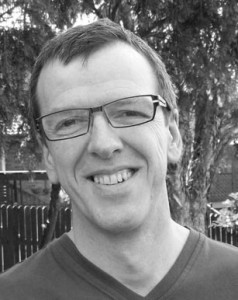 Keith Stevenson is a speculative fiction writer, editor, reviewer, publisher and podcaster. In 2014 he launched Dimension6 magazine and began reviewing speculative fiction for the Newtown Review of Books. His new science fiction novel Horizon will be published by Harper Impulse in early December.
Keith Stevenson is a speculative fiction writer, editor, reviewer, publisher and podcaster. In 2014 he launched Dimension6 magazine and began reviewing speculative fiction for the Newtown Review of Books. His new science fiction novel Horizon will be published by Harper Impulse in early December.
1. The latest coeur de lion project is Dimension6, an online periodical publication. What made you pursue this publication model, and how is it going?
A lot of thoughts and ideas about my work to date with coeur de lion made Dimension6 inevitable really.
Firstly, just to explain for those who haven’t heard of it, Dimension6 is a free electronic magazine in epub and mobi format that is published by coeur de lion three times a year. Each issue features three pieces of original fiction, and each author also has space to talk about their story, spruik their other works and add links to their blog, twitter feed, facebook page etc. etc. We carry advertising but we don’t charge for that, preferring to trade ads with other sites and publications. The stories are published DRM free and are distributed under a Creative Commons licence which means anyone is free to take the file, copy it and distribute it to whoever they want as long as they don’t change the content, claim it as their own or charge for it. For that reason D6 is also distributed through a range of affiliate sites including sites run by spec fic readers, other publishers, and spec fic authors.
So, why is D6 set up this way? The last few projects I’ve worked on for coeur de lion took a couple of years each, which is a long time in anyone’s book. I wanted to work on something with a fast turnaround (and get some instant gratification :-) ). The production schedule for D6 is a slim twelve weeks from initial edit to distribution.
The other thing I’ve found is just how hard it is to sell books and ebooks, particularly when you’re competing with thousands of other titles published each month. Removing the paywall, means there’s no barrier between the reader’s impulse to consume D6 and their decision to acquire it. It makes the whole transaction that much simpler. As I’ve said elsewhere, Cory Doctorow has no qualms about giving stuff away, and it can be beneficial to an author to do so because it’s means they are more likely to get read – which is kind of the whole idea in this writing lark – and the ‘gift’ of the work makes the reader more predisposed towards the author, for example to have a look at what else they’ve produced and maybe even buy some of their other stuff. D6 is a marketing tool for the authors that appear in it and for coeur de lion as a whole. We’re earning karma points with the great reading public.
The other element to being free is that we are not in competition with anyone else for the limited reading dollar that a particular customer has. This fosters business to business cooperation which makes it easier for D6 to appear on other websites, for example, another speculative fiction publisher.
The final thing that I like about going electronic is that, unlike the print medium, those D6 stories will never go out of print. They’ll always be immediately accessible. That’s why I did the Terra Incognita podcast (www.tisf.com.au) and it’s why I do D6.
So the whole model really supports what has always been our key aim at coeur de lion: to bring great Australian speculative fiction writing to as wide an audience as possible.
In terms of how it’s going, we’ve had some very positive feedback. We have a mailchimp list with with seventy-two subscribers (and you can join it herehttp://eepurl.com/AIKWv) and the first two issues have been downloaded over three hundred times (not counting downloads from our affiliate sites). And our next issue out in October 3 features new work by Robert Hood, Cat Sparks and Steve Cameron.
Oh, and you can download Dimension6 here http://ow.ly/uJGJK.
2. You published coeur de lion’s first original novel in 2012, Adam Browne’s very well-reviewed debut Pyrotechnicon. What did you find were the main differences in producing a novel as opposed to an anthology or collection, which you’ve done in the past?
I think the key difference is that – as a publisher – I’m working with one person instead of thirty. The author has far more ownership than say someone who’s written a fifteen page story in a four hundred page book. And a debut novel is a huge thing for an author as well. There’s a lot riding on it. So the dynamic was very different and there was far more negotiation and discussion between us, not just about the words on the page, but about the look of the book, the physicality of it as an object. Adam is a good friend and has been for many years, but he’d agree that for both of us there were a few times when we found the process personally challenging, when we had different ideas about things. That meant we both had to work really hard to find solutions. And I think we both feel we achieved something really special in the final analysis. It’s a beautiful story with real heart, amazing invention and great action, and the layout, the illustrations and the cover really make it something you want to pick up, touch and open.
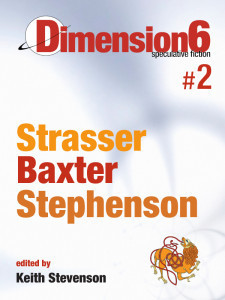 3. You’re working on Dimension6 as an ongoing project, but is there anything else on the horizon for coeur de lion (or Keith Stevenson) that you can tell us about?
3. You’re working on Dimension6 as an ongoing project, but is there anything else on the horizon for coeur de lion (or Keith Stevenson) that you can tell us about?
Well for coeur de lion, we’ll concentrate on D6 for a while to really consolidate it and see what else turns up. And for any authors out there our next reading period opens on 1 November. More details at www.coeurdelion.com.au.
For myself I’m feeling more than a little blown away that HarperCollins have bought my science fiction novel Horizon which will be published in early December through their digital-first imprint Impulse. Horizon combines space exploration with murder, betrayal, political intrigue and a lot of cool science all played out in the cramped confines of a starship 70 light years from Earth. You can find out more about Horizon on my blog at http://keithstevensonwriter.blogspot.com.au/
The other thing I’ve been busy with is a business I run with my partner, freelance editor Nicola O’Shea. Ebookedit provides a full range of professional editing and ebook and print book file conversion and layout services to indie authors. We’ve been up and running for six months now and really enjoying working with some amazing writers. Our website is at www.ebookedit.com.au.
Apart from all that, I’m still plugging away at my three book space opera The Lenticular Series, and reviewing books for the Newtown Review of Books (http://newtownreviewofbooks.com/). So I’m no slouch at the moment!
4. What Australian works have you loved recently?
I think we’re experiencing another wave of fantastic Australian talent right now. There are some great writers out there and I’ve really enjoyed Rjurik Davidson’s Unwrapped Sky, Marianne De Pierres’ Peacemaker, and Andrew Macrae’s Trucksong. And Max Barry’s Lexicon is so good I can’t recommend it highly enough. I’m also enjoying Alan Baxter’s Bound right now and looking forward to reading Ben Peek’s Godless. Really, we’re spoiled for choice here. On the non-Australian side, other books I’ve loved lately include Christopher Priest’s The Adjacent, which is delightfully baffling, Paul McAuley’s The Quiet War series and Anne Leckie’s Ancillary Justice.
5. Have recent changes in the publishing industry influenced the way you work? What do you think you will be publishing in five years from now?
It’s all about digital now, and for an independent publisher that has just made things so much easier for me and a lot more cost effective than the bad old days of having boxes of books in the basement that I hope I can sell, or posting bulky bags of books to customers. It’s been a real boon, but with more and more content being published as a result of all this freedom, discoverability is becoming more and more difficult. So you have to take the good with the bad. But I’m hopeful that quality will always win out in the end.
Five years from now I’d like to still be doing D6!
 This interview was conducted as part of the 2014 Snapshot of Australian Speculative Fiction. We’ll be blogging interviews from 28
July to 10
August and archiving them at SF Signal.
You can read interviews at:
This interview was conducted as part of the 2014 Snapshot of Australian Speculative Fiction. We’ll be blogging interviews from 28
July to 10
August and archiving them at SF Signal.
You can read interviews at:
http://bookonaut.blogspot.com.au/search/label/2014snapshot
http://www.davidmcdonaldspage.com/tag/2014snapshot/
http://fablecroft.com.au/tag/2014snapshot
http://helenstubbs.wordpress.com/tag/2014snapshot/
http://jasonnahrung.com/tag/2014snapshot/
http://kathrynlinge.livejournal.com/tag/2014snapshot
http://mayakitten.livejournal.com/tag/2014snapshot
http://www.merwood.com.au/worldsend/tag/2014snapshot
http://crankynick.livejournal.com/tag/2014snapshot
http://randomalex.net/tag/2014snapshot/
http://stephaniegunn.com/tag/2014snapshot/
http://tansyrr.com/tansywp/tag/2014snapshot/
http://tsanasreads.blogspot.com/search/label/2014snapshot
July 30, 2014
Snapshot 2014: Andrea K Höst
Andrea K Höst writes what she likes to read: stories about worlds where magic is real, women aren’t relegated to the background, and expectations are twisted slightly out of skew.
1. You’ve given a (worth reading) breakdown of one of the reasons you decided to self-publish your work on your website, so I don’t want to go into that here. However, I would love to hear about your process for getting your books out there – what are the best and worst bits of being a self-publisher?
The best bit is the readers: I get some lovely fan mail, and it brightens my day every time. Though that’s something to be found in all forms of publishing. For the self-publishing aspect, I’ll cite the standard ‘control’ and also freedom from the submission-go-round.
The mechanical parts – getting covers, working out how to create an ebook – are fun (or can be out-sourced, if you don’t find that kind of thing fun), but the first year, before you’ve built any form of audience, can be extremely daunting. Self-publishing works in a very different way from trade publishing. There is none of the pressure to make a big debut, to get out of the gate with a bang so as to be able to sell the next book. But there’s also no-one firing you out of that gate, no advocate going around hanging superlatives off your work. You’re a drop in the ocean and shouting will get you nowhere.
Fortunately, I’ve found the ‘set and forget’ method of promotion (with occasional freebies and a couple of judicious ads) works quite well for me. Self-pub is definitely a path that fits with a five year plan outlook, rather than attempting to shoot your first book into the stratosphere.
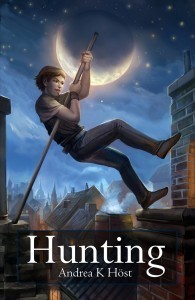 2. You have had two novels shortlisted for the Aurealis Awards in recent years. In fact, I think you may have been one of the first self-published writers to achieve this, which is fantastic. Can you tell us why you think your work hit that milestone?
2. You have had two novels shortlisted for the Aurealis Awards in recent years. In fact, I think you may have been one of the first self-published writers to achieve this, which is fantastic. Can you tell us why you think your work hit that milestone?
There’s no real answer to that question. The more books and reviews I read, the less I believe in a “best”. Every single person has their very own taste, and standards of excellence, and I was enormously fortunate that those three books happened to work for the particular combination of judges in their respective years. It’s an amazing compliment, though, and I still remember the walking on air feeling for when Medair was nominated.
3. What’s coming up next from you, and what are your goals as an author?
I’m currently working on a kitchen-and-the-sink alt-history series called The Trifold Age. More mythology mashed into one monstrous mass than my ability to alliterate can maintain! The first volume, The Pyramids of London, will be out either at the end of this year, or early next year.
My goals as an author are fairly straightforward. Keep writing books. Keep growing my fan base. Have fun. Hopefully write full time some day. [That last is problematic, as my absolute most productive time to write is on the train during the morning commute!
4. What Australian works have you loved recently?
The last Australian books I read were Malaysian-Australian author K S Augustin’s Check Your Luck Agency series, which hit my sweet spot for both narrative voice and for a fun trip into both supernatural and everyday Singapore and Malaysia.
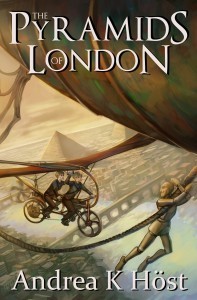 5. Have recent changes in the publishing industry influenced the way you work? What do you think you will be publishing in five years from now?
5. Have recent changes in the publishing industry influenced the way you work? What do you think you will be publishing in five years from now?
The most direct impact on my writing has been what I call the positive circle - I have a more positive attitude toward my writing due to fan feedback and encouragement. This leads me to write more, and to push myself as a writer.
In five years, I expect to be finishing up The Trifold Age, and probably mired in half a dozen other partials. One thing I’m not short of is ideas. 
 This interview was conducted as part of the 2014 Snapshot of Australian Speculative Fiction. We’ll be blogging interviews from 28
July to 10
August and archiving them at SF Signal.
You can read interviews at:
This interview was conducted as part of the 2014 Snapshot of Australian Speculative Fiction. We’ll be blogging interviews from 28
July to 10
August and archiving them at SF Signal.
You can read interviews at:
http://bookonaut.blogspot.com.au/search/label/2014snapshot
http://www.davidmcdonaldspage.com/tag/2014snapshot/
http://fablecroft.com.au/tag/2014snapshot
http://helenstubbs.wordpress.com/tag/2014snapshot/
http://jasonnahrung.com/tag/2014snapshot/
http://kathrynlinge.livejournal.com/tag/2014snapshot
http://mayakitten.livejournal.com/tag/2014snapshot
http://www.merwood.com.au/worldsend/tag/2014snapshot
http://crankynick.livejournal.com/tag/2014snapshot
http://randomalex.net/tag/2014snapshot/
http://stephaniegunn.com/tag/2014snapshot/
http://tansyrr.com/tansywp/tag/2014snapshot/
http://tsanasreads.blogspot.com/search/label/2014snapshot
http://ventureadlaxre.wordpress.com/tag/2014snapshot/
July 29, 2014
Snapshot 2014: Mark Harding
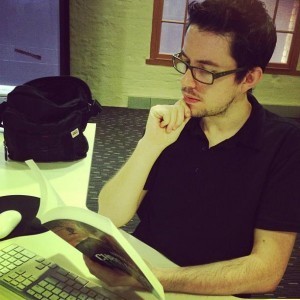 Mark has worked in books and publishing for several years, starting out as a bookseller with Shearer’s Bookshop before making the move to publishing. He’s helped run the When Genres Attack literary events that take place in Sydney, and also writes about Stephen King at The Night Shift: http://thenightshiftblog.wordpress.com/ You can follow him on Twitter at @ml_harding
Mark has worked in books and publishing for several years, starting out as a bookseller with Shearer’s Bookshop before making the move to publishing. He’s helped run the When Genres Attack literary events that take place in Sydney, and also writes about Stephen King at The Night Shift: http://thenightshiftblog.wordpress.com/ You can follow him on Twitter at @ml_harding
You have been working with Momentum as Digital Marketing Executive for over two and a half years, and with the company, have been working on ways to build communities around publishing – why do you think this is so important?
Momentum publishes a lot of genre fiction, and when a genre community embraces a work it can make a huge difference to that title’s success. Genre readers are also voracious, and will devour content quickly – it’s therefore important to be in that community indicating where readers can find more. It’s also rare for publishers to instil brand loyalty. Readers are loyal to authors, but often have no idea who publishes them, aside from a handful of community-focused imprints like Tor. Part of what we’ve tried to do with Momentum is build a community around us in addition to our authors.
What has been the most interesting experience you have had working for Momentum?
I’ve been fortunate to have quite a few things to choose from with this question. I’d have to say that it was seeing the Kylie Scott juggernaut take off. Kylie’s book Lick became an Amazon top 20 bestseller and led to her being offered a 4-book deal with Macmillan. While Lick is a new adult rock star romance, Kylie built herself first with the books Flesh and Skin, erotic romance novels set after a zombie apocalypse. The hook (it’s a zom-rom) was so unique that we were all very curious as to how audiences would respond. And the community loved it. It was very satisfying to be able to help someone go from aspiring writer to full-time author.
You are leaving publishing this month and heading into a different direction altogether. Can you tell us why you’ve made this move?
I’ve had a passion for social media for many years now and I was recently offered an exciting opportunity to manage social for a company outside the publishing industry. It was a tough choice. I’ll miss publishing, but I’ll continue to be a big supporter of the local industry as a fan and customer.
What Australian works have you loved recently?
The Last City and The Forgotten City by Nina D’Aleo are amazing. READ NINA D’ALEO’S BOOKS, I cannot stress this enough. These novels are wonderful works of speculative fiction from a massively talented author. She has a big future ahead of her, so it would be best to read these books ASAP so you can brag about how you knew all about her before she won a Hugo award.
Fury by Charlotte McConaghy is also a brilliant novel that’s set in a really interesting dystopia where an oppressive regime has ‘cured’ the population of negative emotions. That concept is an awesome hook, and Charlotte has structured the story in a really interesting way. It’s the first in a series so there’s a lot more of the world she’s created to be explored.
I’m also partial to crime novels and have to say that Luke Preston’s novels Dark City Blue and Out of Exile are among the most hardcore, riveting and gleefully violent crime noirs around. Luke knows the genre back-to-front and just has an absolute blast torturing his characters.
In one way, Momentum itself is a reaction to changes in publishing, in that’s it’s a digital first imprint – how else did the recent changes in the publishing industry influence the way you work?
We’ve been free to experiment, and much of my role for these two and a half years has been to find out just what it takes to make an ebook successful. It’s an ongoing process as we’re constantly learning new things, and the landscape is shifting all the time.
 This interview was conducted as part of the 2014 Snapshot of Australian Speculative Fiction. We’ll be blogging interviews from 28
July to 10
August and archiving them at SF Signal.
You can read interviews at:
This interview was conducted as part of the 2014 Snapshot of Australian Speculative Fiction. We’ll be blogging interviews from 28
July to 10
August and archiving them at SF Signal.
You can read interviews at:
http://bookonaut.blogspot.com.au/search/label/2014snapshot
http://www.davidmcdonaldspage.com/tag/2014snapshot/
http://fablecroft.com.au/tag/2014snapshot
http://helenstubbs.wordpress.com/tag/2014snapshot/
http://jasonnahrung.com/tag/2014snapshot/
http://kathrynlinge.livejournal.com/tag/2014snapshot
http://mayakitten.livejournal.com/tag/2014snapshot
http://www.merwood.com.au/worldsend/tag/2014snapshot
http://crankynick.livejournal.com/tag/2014snapshot
http://randomalex.net/tag/2014snapshot/
http://stephaniegunn.com/tag/2014snapshot/
http://tansyrr.com/tansywp/tag/2014snapshot/
http://tsanasreads.blogspot.com/search/label/2014snapshot
http://ventureadlaxre.wordpress.com/tag/2014snapshot/
July 28, 2014
Snapshot 2014: Julie Hunt
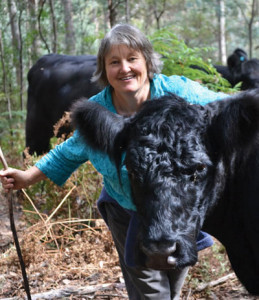 Julie Hunt lives on an organic farm in southern Tasmania where she writes a variety of stories for children – from picture books to novels and graphic novels. She’s interested in folktales, travel and oral storytelling and is endlessly surprised by the way the supernatural and the everyday seem to exist side by side.
Julie Hunt lives on an organic farm in southern Tasmania where she writes a variety of stories for children – from picture books to novels and graphic novels. She’s interested in folktales, travel and oral storytelling and is endlessly surprised by the way the supernatural and the everyday seem to exist side by side.
1. Your most recent novel, Song for a Scarlet Runner, is doing wonderfully well, being shortlisted for the CBCA Younger Readers category and the Children’s category of the Aurealis Awards, and winning the Readings Children’s Book Prize – could you tell us where the idea for the book came from and the road to publication?
The story began with the term ‘marsh auntie’. I don’t know where that came from but those two words were the seed of the idea. They arrived one morning and brought a character and a world with them. I decided the marsh auntie would be a storyteller and herbalist and she’d live in the swamp with a community of aunties and each would have a special skill. A trip to Ireland to attend a storytelling festival helped and other ideas came from reading folktales. I used the notion of the ‘external soul’, an idea that appears in quite a few traditional tales: a person takes their soul from their body and hides it away so they can never be killed, but eventually somebody – the hero or heroine – finds it and time catches up with them.
The road to publication? I was lucky enough to have an Australian Society of Authors mentorship with the illustrator, Ann James, and this led to an introduction to the publisher. Working with Erica, Sue, Sarah and others at Allen and Unwin has been a gift. Although I’m the one writing the stories, the process is collaborative and feels very much like a joint effort.
2. Several of your books have received Awards recognition, which must be exciting, but does it come with a weight of expectation too? How do you deal with that as you keep writing?
I don’t feel any weight. Recognition is encouraging and it gives me confidence. There does seem to be an expectation to speak though, and that’s something I find tricky. Still, speaking is not as hard as writing. If Song for a Scarlet Runner had been easy to create – if it had just slipped out ‘accidently’ – I would be worried that I couldn’t do it again, but it was hard won.
3. Tell us what can we look forward to from you in the next 12 months?
My graphic novel, KidGlovz, will be published in 2015. Dale Newman, who did the beautiful cover illustration for Song for a Scarlet Runner, is the artist. It’s a book for 10–14 year-olds about a child prodigy, a pianist. He wears a pair of white gloves and when he discovers the gloves have a sinister past he begins to realise that his talent is a curse and that his wierd musical ability actually lies in the gloves rather than in his fingers.
I read up on 19th century prodigies before I started the story and I wrote much of the book while visiting Romania. My story is full of mountains and music and ice caves. I was amazed at the painted monasteries in Bucovina – graphic novels, comic strips on the walls of the buildings! – that went straight into the book and although I didn’t visit Transylvania, it was on my mind.
I’m working on a sequel to KidGlovz. It will be a hybrid novel, part graphic novel and part prose and will follow the gloves into their next incarnation. They leave the pianist and return on the hands of a thief, a young pickpocket and they give him the ability to steal whatever he desires – hearts, minds and souls.
4. What Australian works have you loved recently?
The Dead I Know by Scot Gardner. What the Family Needed by Stephen Amsterdam. Sea Hearts by Margo Lanagan. I also enjoyed Andrew McGahan’s The Coming of the Whirlpool and The Four Seasons of Lucy McKenzie by Kirsty Murray. I loved Tantony by Ananda Braxton-Smith for the marvellously inventive language and Alison Croggon’s Black Spring for the landscape and the intrigues.
5. Have recent changes in the publishing industry influenced the way you work? What do you think you will be publishing in five years from now?
I’ve only begun publishing in a consistent way recently so I can’t say the changes have effected me. Being able to download ebooks has helped my work, and being able to find lost books online has been wonderful. I worry about bookshops and I worry that the library is throwing out too many books. I’m both attracted and repelled by changes in technology. I don’t tweet but I can see the possibilities of augmented reality. A while ago I met an inspiring software developer and considered creating an app based on one of my picture books. I’m open to new ways of storytelling and was pleased when Bologna Book Fair introduced its digital award in children’s publishing.
Perhaps in five years time I’ll have extended my stories into other areas. As far as print goes, one book seems to lead to the next, so I expect whatever I’m writing then will be a continuation of my present work. At the moment I’m experimenting with a story cycle, collection of linked stories for a young adult audience set in a world full of criss-crossing roads, trails and pathways.
 This interview was conducted as part of the 2014 Snapshot of Australian Speculative Fiction. We’ll be blogging interviews from 28
July to 10
August and archiving them at SF Signal.
You can read interviews at:
This interview was conducted as part of the 2014 Snapshot of Australian Speculative Fiction. We’ll be blogging interviews from 28
July to 10
August and archiving them at SF Signal.
You can read interviews at:
http://bookonaut.blogspot.com.au/search/label/2014snapshot
http://www.davidmcdonaldspage.com/tag/2014snapshot/
http://fablecroft.com.au/tag/2014snapshot
http://helenstubbs.wordpress.com/tag/2014snapshot/
http://jasonnahrung.com/tag/2014snapshot/
http://kathrynlinge.livejournal.com/tag/2014snapshot
http://mayakitten.livejournal.com/tag/2014snapshot
http://www.merwood.com.au/worldsend/tag/2014snapshot
http://crankynick.livejournal.com/tag/2014snapshot
http://randomalex.net/tag/2014snapshot/
http://stephaniegunn.com/tag/2014snapshot/
http://tansyrr.com/tansywp/tag/2014snapshot/
http://tsanasreads.blogspot.com/search/label/2014snapshot
http://ventureadlaxre.wordpress.com/tag/2014snapshot/
July 27, 2014
Snapshot 2014: Philippa (Pip) Maddern, in memorium

Image via History of Emotions
PHILIPPA MADDERN
(1952-2014)
By Lucy Sussex
I became a writer because of the Australian SF writing workshops. Ursula Le Guin’s name on the cover of the 1975 workshop proceedings, The Altered Eye, was sufficient for me to buy the book. Then I got entranced by the descriptions of the workshop process. I bought The View from the Edge, too. Although they featured various talented young writers, some of whom would publish books, the absolute standout was one Philippa C. Maddern.
It was some years till I met Pip (as people called her), at a restaurant meal around Aussiecon II. I noticed first the mop of black hair, the wide, warm smile. At the time I was considerably in awe. Viv Albertine’s recent memoir describes the effect of seeing the cover of Patti Smith’s Horses; and then the Sex Pistols live. Smith looked like an ‘ordinary girl’, the Pistols like Viv and her friends: young outsiders. When I started out the stars of the Oz SF scene were almost to a man hoary old blokes, tending to the deeply sexist. The women of SF were unattainable goddesses, and overseas. Pip was older than me, but otherwise young, acclaimed and an Aussie girl. I found her inspirational. Moreover, she was a strong feminist.
Not that I could get all fangirl over Pip and a story I adored—“Ignorant of Magic”—because she did not stand upon ceremony. If she liked you, then you knew it. Neither did she hide a razor-sharp intelligence. Her obituary photograph in the Australian was pure Pip: hands on hip, the background cluttered bookcases, feistiness in repose.
In the years following the workshops, she pursued a PhD in medieval history at Oxford, and attended Milford three times. Lisa Tuttle posted on Facebook a photo of Pip at Milford, resplendent in red overalls. Pip’s problem was finding time to write, as a young academic. I can’t remember who suggested an informal series of workshops, which took place over the next few years in our various houses. Pip hosted at her College rooms at Melbourne University, and also at the Champion’s, with whom she had formed a long-lasting Christian community. Although she was deeply religious, she never bothered others about God. She had her worldly pleasures too: she cooked well, and played in a medieval music ensemble.
I knew her best in these few workshop years, and then not well. She was looking for an academic niche, then beginning to be fiendishly difficult, and at one stage got fed up and got an ordinary job. Had she not got a permanent position at the University of West Australia, she might have written more. I heard (not from Pip) of an unpublished novel, and at the workshops she presented extracts from another novel, a human repetends, a love triangle repeating the same mistakes through time. It was very good, but I suspect she never finished it. I did, however, manage to get a story from her for She’s Fantastical.
At various parties I met people from the original workshops, who had a persistent bond. One was Ted Mundie, older, part-Chinese, a charmer in person and prose, with a very relaxed style. One time I saw Pip she mentioned she was ‘having a fling’ with Ted. Next thing they got married—some 25 years after meeting at the Le Guin workshop. I visited them at their Bayswater home, he enjoying looking after her; she cherishing him. Sadly Ted died of a heart attack after 5 years of marriage. The last email I had from Pip, we were both bereaved, and she mentioned publishing his memoir. It was one of those things that she never got around to, but such is the state of academe, the grind of lectures, committees, publications, research etc, etc.
She had ovarian cancer as a young woman. The disease returned, this time fatally. I was told by her fellow medievalists that she was gravely ill, and was able to send a card. In it, I said how inspirational she had been, and that I hoped she would get back to writing. Later I was one of six people who contributed to her obituary in the Australian, which is how her SF got mentioned. Some academics had never heard of it before.
Her memorial service in Melbourne filled a small church on a cold day. I sat gazing at the stained glass window, through which the leaves of trees, rendered bright green by sunlight and the tinting, could be seen tossing. As the minister spoke of the Redeemer and the Light, and how her last meal had been the Sacrament, I recalled “Ignorant of Magic”. In it she used the words “Kaleidoscopic precision”, a good image of how her mind, and by extension her prose worked.
What she leaves, beside a memory of an excellent woman, talented historian and teacher, is her stories. ‘The Ins and Outs of the Hadya City State” was her submission to the 1975 workshop, and it remains a startling debut. It was written under the influence of Le Guin (like we all were!), as was “Ignorant of Magic”, this time mixed with medievalism. In retrospect, the best is “Inhabiting the Interstices”, a scary but utterly prescient story of the future of cities, the future of work. What was sitting in her bottom drawer or hard drive is unknown, but what was published was extraordinary.
Ursula Le Guin gave me permission to quote her words about Pip:
It grieves me very much to know Philippa is dead, yet it gives me joy to remember her in life. Teaching workshops you meet a few people like her, you smile when you think about them, you always are grateful to them for being who they were, for writing what they wrote, for believing that you could teach them anything.
I still have a tiny box Philippa gave me. I had told her that when I saw Blue Wattle acacias flowering in Australia they made me feel at home, because they grew at our place in California, and in the box is a sprig of those blossoms, still yellow after all the years.
This post is part of the 2014 Snapshot of Australian Speculative Fiction. We’ll be blogging interviews from 28 July to 10 August and archiving them at SF Signal. You can read interviews at:
http://bookonaut.blogspot.com.au/search/label/2014snapshot
http://www.davidmcdonaldspage.com/tag/2014snapshot/
http://fablecroft.com.au/tag/2014snapshot
http://helenstubbs.wordpress.com/tag/2014snapshot/
http://jasonnahrung.com/tag/2014snapshot/
http://kathrynlinge.livejournal.com/tag/2014snapshot
http://mayakitten.livejournal.com/tag/2014snapshot
http://www.merwood.com.au/worldsend/tag/2014snapshot
http://crankynick.livejournal.com/tag/2014snapshot
http://randomalex.net/tag/2014snapshot/
http://stephaniegunn.com/tag/2014snapshot/
http://tansyrr.com/tansywp/tag/2014snapshot/
http://tsanasreads.blogspot.com/search/label/2014snapshot
http://ventureadlaxre.wordpress.com/tag/2014snapshot/
July 26, 2014
The Australian Spec Fic Snapshot 2014
 Snapshot has taken place four times in the past 10 years. In 2005, Ben Peek spent a frantic week interviewing 43 people in the Australian spec fic scene, and since then, it’s grown every time, now taking a team of interviewers working together to accomplish!
Snapshot has taken place four times in the past 10 years. In 2005, Ben Peek spent a frantic week interviewing 43 people in the Australian spec fic scene, and since then, it’s grown every time, now taking a team of interviewers working together to accomplish!
In the lead up to Worldcon in London, we will be blogging interviews for Snapshot 2014, conducted by Tsana Dolichva, Nick Evans, Stephanie Gunn, Kathryn Linge, Elanor Matton-Johnson, David McDonald, Helen Merrick, Jason Nahrung, Ben Payne, Alex Pierce, Tansy Rayner Roberts, Helen Stubbs, Katharine Stubbs, Tehani Wessely and Sean Wright. Last time we covered nearly 160 members of the Australian speculative fiction community with the Snapshot – can we top that this year?
To read the interviews hot off the press, check these blogs daily from July 28 to August 10, 2014, or look for the round up on SF Signal when it’s all done:
This year’s interviewers:
Tsana Dolichva
Nick Evans
Stephanie Gunn
Kathryn Linge
Elanor Matton-Johnson
David McDonald
Helen Merrick
Jason Nahrung
Ben Payne
Alex Pierce
Tansy Rayner Roberts
Helen Stubbs
Katharine Stubbs
Tehani Wessely
Sean Wright




